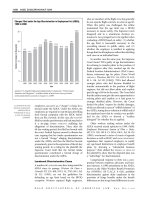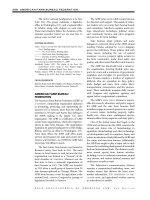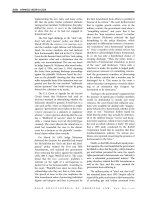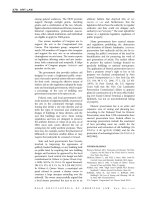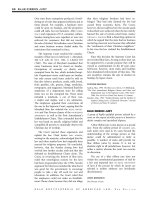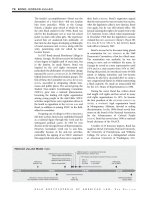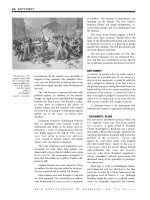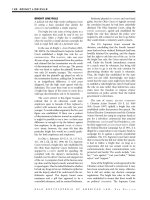Gale Encyclopedia Of American Law 3Rd Edition Volume 9 P39 pptx
Bạn đang xem bản rút gọn của tài liệu. Xem và tải ngay bản đầy đủ của tài liệu tại đây (524.16 KB, 10 trang )
right of a defaulting mortgagor to reclaim pro-
perty by paying all past due mortgage payments
anytime prior to foreclosure. Statutory redemp-
tion, by contrast, begins at the point of fore-
closure and requires that the defaulting mortgagor
pay the full fo reclosure sale price. Equitable
redemption is a common-law concept, which
means it exists as law in the form of judicial
opinions. All state courts have recognized a
mortgagor’s right to equitable redemption.
FURTHER READINGS
Bauer, Patrick B. 1985. “Statutory Redemption Reconsidered:
The Operation of Iowa’s Redemption Statute in Two
Counties between 1881 and 1980.” Iowa Law Review
70 (January).
Nelson, Grant S. 2007. “The Foreclosure Purchase by the
Equity of Redemption Holder or Other Junior Inter-
ests.” Missouri Law Review 72 (fall).
Palace, Eric S. 1996. “In Re BFP: Just a Band-Aid?—Looking
for a Stable Solution that Balances Creditors’ and
Debtors’ Rights under Bankruptcy Code Section 548(A)
(2).” Annual Review of Banking Law 15 (annual).
Peeler, Ronald L. 1986. “Statutory Redemption—Redemption
of Property by the Debtor or Debtor’s Assignee during
the Exclusive Statutory Period Extinguishes a Junior
Lienor’s Right of Redemption.” Drake Law Review 35
(summer).
STAY
The act of temporarily stopping a judicial proceed-
ing through the order of a court.
A stay is a suspension of a case or a suspension
of a particular proceeding within a case. A judge
may grant a stay on the motion of a party to
the case or issue a stay sua sponte, without the
request of a party. Courts will grant a stay in a
case when it is necessary to secure the rights of
a party.
There are two main types of stays: a stay of
execution and a stay of proceedings. A stay of
execution postpones the enforcement of a
judgment against a litigant who has lost a case,
called the
JUDGMENT DEBTOR. In other words, if a
civil litigant wins money damages or some other
form of relief, he may not collect the damages
or receive the relief if the court issues a stay.
Under rule 62 of the Federal Rules of Civil
Procedure, every civil judgment is stayed for ten
days after it is rendered. An additional stay of
execution lasts only for a limited period. It
usually is granted when the judgment debtor
appeals the case, but a court may grant a stay
of execution in any case in which the court feels
the stay is necessary to secure or protect the
rights of the judgment debtor.
The term stay of execution may also refer to a
halt in the execution of a death penalty. This
kind of stay of execution normally is granted
when a court decides to allow an additional
appeal by a condemned prisoner. Such stays of
execution may be granted by executives, such
as governors or the president of the United
States, or by appeals courts.
A stay of proceedings is the stoppage of an
entire case or a specific proceeding within a
case. This type of stay is issue d to postpone a
case until a party complies with a court order
or procedure. For example, if a party is required
to deposit collateral with the court before a
case begins, the court may order the proceed-
ings stayed for a certain period of time or until
the money or property is delivered to the court.
If the party fails to deposit the collateral, the
court may cite the party for
CONTEMPT of court
and impose a fine or order incarceration.
A court may stay a proceeding for a number of
reasons. One common reason is that another
action is under way that may affect the case or the
rights of the parties in the case. For instance,
assume that a defendant faces lawsuits from the
same plaintiffs in two separate cases involving
closely related facts. One case is filed in federal
court, and the other case is filed in state court. In
this situation one of the courts may issue a stay in
deference to the other court. The stay enables the
defendant to concentrate on one case at a time.
The term stay may also be used to describe
any number o f legal measures taken by a
legislature to provide temporary relief to debtors.
For example, under section 362(a) of the Bank-
ruptcy Code, a debtor who files for bankruptcy
receives an automatic stay immediately upon
filing a voluntary bankruptcy petition. Used in
this sense, the term stay refers to the right of the
debtor to keep creditors at bay during the
resolution of the bankruptcy case.
FURTHER READING
Hazard, Geoffrey C., Jr., Colin C. Tait, and William A.
Fletcher. 2009. Cases and Materials on Pleading and
Procedure: State and Federal. 10th ed. Westbury, N.Y.:
Foundation Press.
CROSS REFERENCE
Capital Punishment.
STEERING
The process whereby builders, brokers, and rental
property managers induce purchasers or lessees of
GALE ENCYCLOPEDIA OF AMERICAN LAW, 3RD E DITION
368 STAY
real property to buy land or rent premises in
neighborhoods composed of persons of the same
race.
Steering is an unlawful practice and includes
any words or actions by a
REAL ESTATE sales
representative or
BROKER that are intended to
influence the choice of a prospective buyer or
tenant. Steering violates Section 804 of the federal
Fair Housing Act, a provision that proscribes
DISCRIMINATION in the sale or rental of housing.
The Housing and Civil Enforcement Section
of the Department of Justice’s
CIVIL RIGHTS
Division has a fair housing testing program. Since
1991, it has trained and sent over 1,000 trained
personnel to investigate patterns of steering in
housing markets. These individuals pose as
buyers or renters in order to gather information
about possible discrimination in housing. As of
2009, the Department has recovered more than
$12 million in fines and damages resulting from
more than 80 suits filed.
FURTHER READING
U.S. Department of Justice Civil Rights Division. “Housing and
Civil Enforcement Division” />housing/housing_testing.php (accessed September 28,
2009).
CROSS REFERENCES
Civil Rights; Di scrimination; Racial and E thnic Discrimination.
v
STEINEM, GLORIA
GLORIA STEINEM is one of the most importa nt
feminist writers and organizers of the late
twentieth century. Since the 1960s, Steinem
has been a political activ ist and organizer who
has urged equal opportunity for women and the
breaking down of gender roles. As a writer she
has produced influential essays about the need
for social and cultural change.
Steinem was born on March 25, 1934, in
Toledo, Ohio . Her parents divorced when she
was 11 years old. Steinem enrolled at Smith
College in 1952 and graduated in 1956. After
graduation she went to India to study at the
universities of Delhi and Calcutta. It was there
that she began publishing freelance articles in
newspapers.
In the 1960s, Steinem continued to pursue
a writing career, working first for a political
satire magazine in New York. Her breakthrough
came in 1963 with the publication of her article
“I Was a Playboy Bunny,” which retold her
Gloria Steinem.
AP IMAGES
Gloria Steinem 1934–
▼▼
▼▼
❖
1961–73
Vietnam War
◆
1950–53
Korean War
1939–45
World War II
1934 Born,
Toledo, Ohio
◆
◆◆ ◆
◆
◆
◆
◆
◆
◆◆
◆
1956 Graduated from Smith College
1960 Moved to New York to pursue writing career
1963 “I Was a Playboy Bunny” published
1968–72 Wrote for New York magazine
1972 Founded Ms. magazine
1971 Co-founded the National Women’s Political Caucus with
Betty Friedan, Bella Abzug, and Shirley Chisholm
1972–87
Served as editor
of Ms. magazine
1986
Marilyn
published
1983 Outrageous Acts and
Everyday Rebellions published
2000 Addressed 3-day
international Feminist Expo
2000 in Baltimore, Md.
1997 Feminist Family Values published
1992 Revolution from Within: A
Book of Self-Esteem published
1994 Moving Beyond Words published
2006 Doing
Sixty and
Seventy
published
2002 Celebrated 30th
anniversary of founding
of Ms. magazine
2000
1975
1950
STEINEM, GLORIA 369
GALE ENCYCLOPEDIA OF AMERICAN LAW, 3RD E DITION
experiences working in the Manhattan Playboy
Club. For the next few years, her articles appeared
in many national women’s magazines. Steinem
also wrote comedy scripts for a weekly politi-
cal satire television show, That Was the Week
That Was.
Her attention shifted to politics in 1968 when
Steinem began writing a column for New York
magazine. During the late 1960s, the “women’s
liberation movement” began and Steinem soon
became a leading supporter of the movement. In
1971 she, along with
BETTY FRIEDAN, BELLA ABZUG,
and
SHIRLEY CHISHOLM, founded the National
Women’s Political Caucus. The mission of the
caucus was to identify and encourage women to
run for political office.
In 1972 Steinem founded and served as
editor of Ms. magazine. Ms. addressed feminist
issues, including reproductive rights, employ-
ment
DISCRIMINATION, sexuality, and gender roles.
The magazine presented Steinem with a plat-
form to air her views about the contemporary
social scene. That same year Steinem was one
of the cofounders of the Ms. Foundation for
Women, a nonprofit organization that pioneered
the concept of giving money to programs that
addressed the specific concerns of women. At
that time less than one percent of foundation
grants were given to programs that supported
women’sissuessuchas
DOMESTIC VIOLENCE, female-
friendly legislation, and economic disparities.
Since the 1970s, Steinem has been a spokes-
person for many feminist causes. She has sought
to protect
ABORTION rights, establish RAPE crisis
centers, and guarantee work environments free
from sexual discriminatio n. Steinem has distin-
guished between “erotica” and
PORNOGRAPHY,
believing that nonviolent sexual material is
acceptable but pornography should be banned.
More radical feminists have criticized Steinem
for these and other positions, arguing that she
seeks legal changes that falsely promise equal
opportunity and fair treatment.
Despite these criticisms, Steinem has
remained a popular public figure, traveling
across the United Stat es and worldwide, and
lecturing to packed audiences. She is a prolific
writer, regularly contributing articles to maga-
zines and newspapers; she also provides politi-
cal commentary on television, radio, and the
INTERNET. A collection of her articles and essays,
Outrageous Acts and Everyday Rebellions, was
published in 1983. In 1986 she published Marilyn,
a biography of film star Marilyn Monroe retold
from a feminist perspective. In Revolution from
Within: A Book of Self-Esteem (1992), Steinem
looked inward, discussing ways that women
could empower themselves. In 1994 she wrote
Moving beyond Words, acollectionofessayson
the politics of gender, and Doing Sixty and Seventy
was published in 2006.
In addition to her numerous awards and
honorary degrees, in 1993, Steinem was inducted
into the National Women’sHallofFamein
Seneca Falls, New York. In 2000 she astonished
observers by getting married at the age of 66 to
an entrepreneur she had met at a Voters for
Choice (VFC) fundraiser in 1999. Steinem is
president of VFC, which is a bipartisan
POLITICAL
ACTION COMMITTEE
that supports candidates work-
ing for reproductive freedom. In May 2002
Steinem and her supporters celebrated the
thirtieth anniversary of the founding of Ms.
magazine.
Steinem was active and vocal regarding the
2008 presidential election. She was quoted as
saying that “Both Senators Clinton and Obama
are
CIVIL RIGHTS advocates, feminists, environ-
mentalists, and critics of the war in Iraq Both
have resisted pandering to the right, something
that sets them apart from any Republican
candidate, including
JOHN MCCAIN. Both have
Washington and foreign policy experience;
GEORGE
W
. BUSH did not when he first ran for president.”
She ended up endorsing Senator Clinton, citing
Clinton’s broader experience. Steinem was
critical of sexist media treatment of the Clinton
campaign. Following McCain’s selection of Sarah
Palin as his running mate, Steinem penned an
op-ed in which she labeled Palin an “unquali-
fied woman.”
FURTHER READINGS
Davis, Flora. 1999. Moving the Mountain: The Women’s
Movement in America since 1960. Champaign: Univ. of
Illinois Press.
Heilbrun, Carolyn G. 1995. The Education of a Woman: The
Life of Gloria Steinem. New York: Dial Press.
Marcello, Patricia Cronin. 2004. Gloria Steinem: A Biogra-
phy. Westport, Conn.: Greenwood Press
Stern, Sydney Ladensohn. 1997. Gloria Steinem: Her
Passions, Politics, and Mystique. Secaucus, N.J.: Carol
Pub. Group.
CROSS REFERENCES
Dworkin, Andrea; Feminist Jurisprudence; Ireland, Patricia;
MacKinnon, Catharine Alice; Millett, Katherine Murray;
Sex Discrimination; Women’s Rights.
370 STEINEM, GLORIA
ECONOMIC SYSTEMS
ARE NOT VALUE
-FREE
COLUMNS OF
NUMBERS BASED ON
RULES OF REASON
,
BUT WAYS OF
EXPRESSING WHAT
VARYING SOCIETIES
BELIEVE IS
IMPORTANT
.
—GLORIA STEINEM
GALE ENCYCLOPEDIA OF AMERICAN LAW, 3RD E DITION
STEM CELL RESEARCH
See FETAL TISSUE RESEARCH.
STENOGRAPHER
An individual who records court proceedings either
in shorthand or through the use of a paper-punching
device.
A court stenographer is an officer of the
court and is generally considered to be a state
or public official. Appointment of a court steno-
grapher is largely governed by statute. A stenogra-
pher is ordinarily appointed by the court as an
official act, which is a matter of public record.
He or she is an official under the control of the
court and is, therefore, generally subject to its
direction. A stenographer is not under the
dominion and control of the attorneys in a case.
The term of office of a court stenographer is
also regulated by statute in most cases.
The stenographer has the duty to attend court
and to be present, or on call, throughout the entire
trial, so that the court and the litigants can be
protected by a complete record ofthe proceedings.
The stenographer must take notes of what occurs
before the court and transcribe and file the notes
within the time permitted. The notes must comply
with provisions requiring the stenographer to
prepare and sign a certificate stating that the
proceedings, evidence, and charges levied against
the defendant were fully and accurately taken at
the trial and that the transcript represents an
accurate translation of the notes.
Some statutes provide that a judge who
appoints the stenographer also has the power to
remove him or her. Other statutes fix the term
of office; in w hich case a stenographer cannot
be removed at a judge’s pleasure, even though
the judge has the power to appoint him or her.
The compensation of a court stenographer
may be in the form of an annual salary, a per
diem allowance, or an allowance for work
actually performed. In the absence of a statute
fixing the fees, a duly appointed stenographer is
entitled to be reasonably compensated. Some
statutes require that a stenographer’s fees must
be paid by the parties.
CROSS REFERENCE
Court Reporter.
STERILIZATION
A medical procedure where the reproductive
organs are removed or rendered ineffective.
Legally mandated sterilization of criminals,
or other members of society deemed “socially
undesirable,” has been considered a stain on the
history of U.S. law for some time. The practice
originated early in the twentieth century. In
1914 a Model Eugenical Sterilization Law was
published by Harry Laughlin at the Eugenics
Records Office. Laughlin proposed the steriliza-
tion of “so cially inadequate” persons, which
translated as anyone “maintained wholly or in
part by public expense.” This would include
the “feebleminded, insane, blind, deaf, orphans,
and the homeless.” At the time the model law
was published, 12 states had enacted steriliza-
tion laws. Such laws were seen to benefit society
because they presumably reduced the burden
on taxpayers of maintaining state-run facilities.
Eventually, these laws were challenged in court.
In
BUCK V. BELL, 274 U.S. 200 (1927), Oliver
Wendell Holmes Jr. wrote the infamous opinion
that upheld the constitutionality of a Virginia
sterilization law, fueling subsequent legislative
efforts to enact additional sterilization laws. By
1930, 30 states and Puerto Rico had passed laws
mandating sterilization for many criminal or
moral offenses. Nearly all of the states with such
laws imposed mandatory sterilization of mentally
challenged citizens. Nineteen states required
sterilization for parents of children likely to
experience various disorders. Six states encour-
aged sterilization for individuals whose children
might be “socially inadequate.”
Finally, the
SUPREME COURT struck down an
Oklahoma law mandating involuntary steriliza-
tion for repeat criminals in Skinner v. Oklahoma,
316 U.S. 535, 62 S. Ct. 1110, 86 L. Ed. 1655
(1942). Justice William O. Douglas’s opinion
broadly defined the right to privacy to include
the right to procreate, and concluded that the
government’s power to sterilize interfered with
an individual’s basic liberties.
Skinner v. Oklahoma is often understood to
have ended all compulsory sterilization in the
United States. In reality, however, the only types
of sterilization that the ruling immediately ended
were punitive sterilization, and it did not directly
comment on compulsory sterilization of the
mentally disabled or mentally ill. Skinner did
not
OVERRULE Buck v. Bell. Currently, 18 states
have statutes that authorize court-ordered steril-
ization of mentally disabled individuals. Each law
varies as to the grounds that justify compulsory
sterilization. For example, some apply only to
GALE ENCYCLOPEDIA OF AMERICAN LAW, 3RD E DITION
STERILIZATION 371
those who are unable to give consent, while
some apply only to those who are “mentally
retarded,”“mentally ill,”“brain damaged,”
“developmentally disabled,” or “residents of
state facilities for the mentally ill.” The reason-
ing underlying these laws also varies from state
to state. Whereas some states still employ a
eugenics rationale, most focus on a mentally
disabled woman’s i nability to care adequately for a
child or on the potential physical and psychologi-
cal effects that procreation may have o n her.
FURTHER READINGS
Carlson, Elof Axel. 2001. The Unfit: A History of a Bad Idea.
Cold Spring Harbor, N.Y.: Cold Spring Harbor
Laboratory Press.
Kevles, Daniel J. 1985. In the Name of Eugenics. New York:
Knopf.
Smith, J. David, and K. Ray Nelson. 1999. The Sterilization of
Carrie Buck. Far Hills, N.J.: New Horizon Press.
v
STEVENS, JOHN PAUL
A member of the U.S. Supreme Court since 1975,
John Paul Stevens has developed a reputation as
a judicial centrist on the High Court, although
many of his more well-known opinions are
marked by a liberal bent.
Born on April 20, 1920, Stevens descended
from Nicholas Stevens, who emigrated to America
in 1659 after serving as a brigadier general in
Oliver Cromwell’s army. Stevens’s father was a
businessman and lawyer; he designed Chicago’s
Stevens Hotel and was its original managing
director.
A political moderate during his college days
at the University of Chicago, Stevens graduated
Phi Beta Kappa in 1941. During
WORLD WAR II
he served with the U.S. Navy and was awarded
the Bronze Star. After the war he studied law
at Northwestern University School of Law in
Chicago, graduating first in his class in 1947.
Stevens began his legal career as a law clerk
for U.S. Supreme Court Justice
WILEY B. RUTLEDGE.
In 1948 he joined the Chicago firm of Poppen-
hausen, Johnston, Thompson, and Raymond,
specializing in
LITIGATION and ANTITRUST LAW.In
1951 he served as associate counsel on a study
of
MONOPOLY power for a subcommittee of the
Judiciary Committee of the House of Repre-
sentatives. Upon returning to Chicago in 1952,
Stevens founded the firm of Rot hschild, Ste-
vens, Barry, and Meyers. Along with his private
practice, he taught antitrust law at the North-
western University and the University of Chicago
law schools throughout much of the 1950s. He
also served for a time as a member of the U.S.
attorney general’s National Committee to Study
Antitrust Laws.
In 1970 President
RICHARD M. NIXON
appointed Stevens as a judge of the U.S. Court
of Appeals for the Seventh Circuit. He became
known for his scholarly abilities and his carefully
written, clear, and succinct opinions. His first
opinion on the court of appeals was a
DISSENT in a
challenge to the summary INCARCERATION of an
antiwar activist who had disrupted a legislative
session (Groppi v. Leslie, 436 F.2d 331 [1971]).
Stevens viewed the incarceration as unconstitu-
tional, and the following year his minority view
was vindicated by a unanimous Supreme Court
(404 U.S. 496, 92 S. Ct. 582, 30 L. Ed. 2d 632).
The liberal Supreme Court justice
WILLIAM O.
DOUGLAS retired in 1975, providing President
GERALD R. FORD his only opportunity to make a
Supreme Court appointment. Stevens received
high praise and active support from Ford’s
attorney general,
EDWARD LEVI, and unqualified
support from the
AMERICAN BAR ASSOCIATION.
During the Senate confirmation hearing, Stevens
remarked that he believed that litigants should
know how judges viewed the arguments and that
it was important to make a record to note diverse
views for reference in later cases. Stevens was
unanimously confirmed on December 17, 1975,
and took his oath of office two days later.
Until Stevens became a justice, new justices
were typically seen but not heard. Instead, they
usually joined dissents or concurrences without
offering their own opinions. Stevens did not fit
that pattern. During the 1976–77 term, Stevens
had 17 separate majority concurrences and 27
separate dissents, far more than any other
justice.
From the start, Stevens evinced a concern
that the legal system give particular care to
ensure the rights of the underprivileged, includ-
ing
ALIENS, illegitimate children, and prisoners.
However, Stevens cannot easily be classified as
either a judicial liberal or a conservative. In a
judicial context, a conservative judge generally
will not decide issues that he or she believes are
within the province of legislatures. Moreover, a
conservative typically votes to enhance govern-
ment power in a conflict between government
interests and individual rights. A judicial liberal,
by contrast, tends to favor individual interests
and will look beyond the bounds of a statute
372 STEVENS, JOHN PAUL
GALE ENCYCLOPEDIA OF AMERICAN LAW, 3RD E DITION
and past interpretations of the Constitution to
decide social policy questions.
For example, although Stevens is generally
perceived as being sympathetic to the rights of
prisoners, his sympathy has not necessarily
translated into leniency for criminal defendants.
Stevens wrote the opinion in United States v.
Ross, 456 U.S. 798, 102 S. Ct. 2157, 72 L. Ed. 2d
572 (1982), wherein the Court held that police
may search compartments and containers within
a vehicle even though the co ntents are not in
plain view, as long as the sear ch is based on
PROBABLE CAUSE. Probable cause, the same stand-
ard needed to obtain a
SEARCH WARRANT, is typically
determined by a magistrate, but this case effec-
tively gave that power to the police in searches of
vehicle containers.
Stevens’s nomination was opposed by some
women’s groups that claimed that he was
unresponsive in several sexual
DISCRIMINATION
cases while on the court of appeals. In 1981 he
voted to uphold the all-male draft (
ROSTKER V.
GOLDBERG, 453 U.S. 57, 101 S. Ct. 2646, 69 L. Ed.
2d 478), and in another case he declined to
consider the theory of
COMPARABLE WORTH.On
the other hand, he has typically voted to uphold
ROE V. WADE, 410 U.S. 113, 93 S. Ct. 705, 35 L.
Ed. 2d 147 (1973), and limit restrictions to a
woman’s right to
ABORTION (Planned Parenthood
v. Casey, 510 U.S. 1309, 114 S. Ct. 909, 127 L.
Ed. 2d 352 [1994] and Rust v. Sullivan, 500 U.S.
173, 111 S. Ct. 1759, 114 L. Ed. 2d 233 [1991]).
In Clinton v. Jones, 520 U.S. 681 , 117 S. Ct.
1636, 137 L. Ed. 2d 945 (1997), Stevens spoke
for a unanimous Court in allowing a
SEXUAL
HARASSMENT
lawsuit against President BILL CLIN-
TON
to go forward. Stevens ruled that the
Constitution does not afford a president
temporary immunity—except in the most
▼▼
▼▼
1925
2000
1975
1950
1952 Founded firm
of Rothschild, Stevens,
Barry, and Meyers
◆
2000 Wrote majority opinion banning student-led and-initiated prayer at football games, Santa Fe Independent School District v. Doe;
dissented in Bush v. Gore, warning decision would fuel cynicism about partiality of the U.S. judiciary; Justices Ginsburg and Breyer joined the dissent
◆
1996 Wrote majority opinion in BMW of North America, Inc. v. Gore
1951 Served as associate counsel to the House Judiciary
Committee’s Subcommittee on the Study of Monopoly Power
John Paul Stevens
1920–
❖
1961–73
Vietnam War
1950–53
Korean War
1939–45
World War II
1920 Born,
Chicago, Ill.
◆
◆
◆
◆
◆
◆
◆
1942–45 Served
in the U.S. Navy
1947–48 Clerked for Justice Wiley B. Rutledge
1970–75 Sat
on the U.S.
Court of
Appeals for the
Seventh Circuit
1975– Served as
associate justice
of the U.S.
Supreme Court
1990 Wrote
dissent in
Eichman v.
United States
2003 Wrote 5–4 majority opinion upholding state use of lawyers’ trust account interest to fund legal services for the poor, Brown v. Legal Foundation of Washington
1992 Wrote majority opinion in
Cipollone v. Liggett Group, Inc.
1997 Wrote unanimous opinion for Clinton v. Jones
1999 Dissented in decision limiting the Americans with Disabilities Act, Sutton v. United Air Lines, Inc., calling majority view miserly
◆◆
2002 Dissented in landmark school vouchers decision Zelman v. Simmons-Harris, warning about potential for national religious strife
2000 Presidential election result uncertain due
to disputed Florida vote count; recount halted by
U.S. Supreme Court with 5–4 vote in Bush v. Gore
2001 September 11 terrorist attacks
2006 Wrote majority opinion in Hamdan v. Rumsfeld
◆
◆
John Paul Stevens.
STEVE PETTEWAY,
COLLECTION OF THE
SUPREME COURT OF THE
UNITED STATES
STEVENS, JOHN PAUL 373
GALE ENCYCLOPEDIA OF AMERICAN LAW, 3RD E DITION
exceptional circumstances—for civil litigation
arising from events that occurred before the
president took office. The Court also held that
Clinton was not entitled to a stay of proceedings
during his term in office.
One of Stevens’s earliest opinions was Young
v. American Mini Theatres, Inc., 427 U.S. 50, 96
S. Ct. 2440, 49 L. Ed. 2d 310, (1976). He wrote
for a plurality of the Court, upholding Detroit
ZONING ordinances that prevented the concen-
tration of “adult” establishments. The case was
significant because the ordinance in question
did not require a finding that the establishment
dealt in legally obscene materials as a prerequi-
site to legal action. Before the ruling in Young,
sexually-oriented material that was not legally
obscene appeared to be entitled to complete
FIRST AMENDMENT protection. Stevens wrote that
the material in question was so sexually explicit
as to be entitled to less protection than other
speech, stating that “few of us would march our
sons and daughters off to war to preserve the
citizen’s right to see ‘Specified Sexual Activities’
exhibited in the theaters of our choice.” He
reasoned that the zoning restriction did not
totally prohibit the availability of the material
and was a reasonable action by the city to
further its interest in preserving the quality of
urban life. This ruling has been the basis for
other restrictions that fall short of an outright
prohibition of communication that is sexually
explicit but not obscene.
Justice Stevens, along with Justices
POTTER
STEWART
and LEWIS F. POWELL JR., acted as a swing
vote in a series of death penalty cases in the mid-
1970s. The Court upheld death penalty statutes
providing for discretion in imposition but over-
turned those calling for mandatory death sen-
tences. Stevens voted against the death penalty in
cases of
RAPE and dissented from a 1989 deci-
sion permitting an execution for someone who
committed a
MURDER at age 16 or 17.
In Eichman v. United States, 496 U.S. 310,
110 S. Ct. 2404, 110 L. Ed. 2d 287 (1990), the
Supreme Court ruled that flag burning was a
form of expression protected by the First
Amendment and overturned a federal statute
that attempted to protect flags. The majority
ruled that the statute had to withstand the most
exacting scrutiny and could not be upheld
under the First Amendment. Stevens wrote a
dissent joined by conservative Chief Justice
WILLIAM H. REHNQUIST and two other justices,
maintaining that the statute was consistent with
the First Amendment.
Stevens wrote the opinion in BMW of North
America, Inc. v. Gore, 517 U.S. 559, 116 S. Ct.
1589, 134 L. Ed. 2d 809 (1996), the first case
in which the High Court overturned a jury’s
PUNITIVE DAMAGES award. A jury awarded an
automobile owner $4 million (later reduced to
$2 million) when the manufacturer failed to
disclose a refinished paint job on a new BMW.
Stevens called the award “grossly excessive” and
set out criteria to determine the propriety of
punitive damage awards. The four dissenting
justices in the case argued that the ruling
improperly intruded into states’ prerogatives.
In 1992 Stevens wrote the opi nion for
CIPOLLONE V. LIGGETT GROUP, INC., 505 U.S. 504,
112 S. Ct. 2608, 120 L. Ed. 2d 407 (1992),
possibly exposing the tobacco industry to huge
adverse verdicts for money damages by opening
the door to increased litigation for smoking-
related deaths. In a 7–2 decision, the Court
ruled that cigarette manufacturers that lie about
the dangers of smoking or otherwise misrepre-
sent their products can be sued under state laws.
Because cigarette labeling is governed by federal
law, at issue was whether federal law preempts
state common-law liability lawsuits. The Court
ruled that federal suits are the only avenue for
pursuing failure-to-warn cases or claims of
omissions in the manufacturer’s advertising or
promotions. Litigants may sue in state court,
however, for claims of breaches of express
warranties, claims that cigarette advertisements
are fraudulent, and claims that a company hid
the dangers of smoking from state authorities or
conspired to mislead smokers.
Stevens also authored
WALLACE V. JAFFREE, 472
U.S. 38, 105 S. Ct. 2479, 86 L. Ed. 2d 29 (1985),
holding that a state cannot provide a moment of
silence at the beginning of the school day for the
express purpose of facilitating meditation or
prayer. The Court held that the Alabama statute
in question did not pass constitutional scrutiny.
Recent Decisions
In the first decade of the 2000s, Stevens’s
opinions have continued to cross the political
spectrum, despite the tendency for observers to
cast him as one of the “liberal” justices. In Hope
v. Pelzer, 536 U.S. 730, 122 S. Ct. 2508, 153 L.
Ed. 2d 666 (2002), Stevens wrote a 6–3 majority
opinion ruling that a prison inmate had been
374 STEVENS, JOHN PAUL
IT IS NOT OUR JOB TO
APPLY LAWS THAT
HAVE NOT YET BEEN
WRITTEN
.
—JOHN PAUL
STEVENS
GALE ENCYCLOPEDIA OF AMERICAN LAW, 3RD E DITION
subjected to CRUEL AND UNUSUAL PUNISHMENT in
violation of the
EIGHTH AMENDMENT when prison
guards handcuffed him to a hitching post as
punishment for disruptive behavior, even
though the inmate had already been subdued.
Stevens said that the prison guards knowingly
subjected the inmate to a substantial risk of
physical harm, to unnecessary pain caused by
the handcuffs, to unnecessary exposure to the
heat of the sun, to prolonged thirst and
taunting, and to a deprivation of bathroom
breaks that created a risk of particular discom-
fort and humiliation.
That same year Stevens also wrote a 6–3
majority opinion ruling that the execution of
mentally retarded criminals violates the Eighth
Amendment’s guarantee against cruel and
unusual punishment.
ATKINS V. VIRGINIA, 536
U.S. 304, 122 S. Ct. 2242, 153 L. Ed. 2d 335
(2002). Citing “evolving standards of decency,”
Stevens said that his decision was informed by
the consensus reflected in deliberations of the
American public, legislators, scholars, and
judges that have taken place over the thirteen
years since Penry v. Lynaugh, 492 U.S. 302, 109
S. Ct. 2934, 106 L. Ed. 2d 256 (1989). In Penry,
the Supreme Court held that two state statutes
prohibiting the execution of the mentally
retarded, even when added to the fourteen states
that had rejected
CAPITAL PUNISHMENT completely,
did not provide sufficient evidence of a national
consensus. In Atkins, though, Stevens empha-
sized that sixteen additional states had passed
laws barring execution of the mentally retarded
since the Penry decision was handed down.
Stevens surprised many observers with his
dissenting opinion in Kyllo v. United States, 533
U.S. 27, 121 S. Ct. 2038, 150 L. Ed. 2d 94
(2001), where five justices found that the use of
a thermal-imaging device aimed at a private
home from a public street to detect relative
amounts of heat within the home constituted a
“search” withi n the meaning of the
FOURTH
AMENDMENT
, and thus the use of that device was
presumptively unreasonable without a warrant.
Justice Stevens argued that thermal imaging did
not constitute a Fourth Amendment search
because it detected only heat radiating from the
external surface of the house.
Stevens surprised no one with his dissenting
opinion in
BUSH V. GORE, 531 U.S. 98, 121 S. Ct.
525, 148 L. Ed. 2d 388 (2000), however,
where seven justices concluded that the
process devised by the Florida Supreme Court
to recount the popular vote in the 2000
presidential election violated the
EQUAL PROTEC-
TION CLAUSE
of the FOURTEENTH AMENDMENT.
Only five justices agreed that there was insuffi-
cient time to fashion a remedy that would
fairly and lawfully allow the votes of Florida
residents to be accurately counted for either
presidential candidate. As a result, the nation’s
high court effectively ordered the Florida
recount to stop, which meant that
GEORGE W.
BUSH would become the forty-third president of
the United States.
In his dissenting opinion, Justice Stevens
argued that the Equal Protection Clause does
not limit the states’ power to design their
electoral processes—including substantive stan-
dards for determining whether a vote had been
legally cast. Consequently, Stevens believed that
the U.S. Supreme Court should have deferred
to the Florida Supreme Court’s interpretation
of those standards and allowed the recount to
continue. Under the majority’s own reasoning,
Stevens wrote, the appropriate course of action
would have been to remand the case so the
Florida high court could establish more specific
procedures for implementing the legislature’s
uniform general standard of “voter intent.” But
in “the interest of finality,” Stevens continued,
“the majority effectively orders the disenfran-
chisement of an unknown number of voters
whose ballots reveal their intent—and are
therefore legal votes under state law—but were
for some reason rejected by ballot-counting
machines.”
In one of his most significant decisions,
Hamdan. v. Rumsfeld (2006), Stevens held that
military commissions set up by the Bush
administration to try detainees at Guantanamo
Bay lacked “the power to proceed because
[their] structures and procedures violate both
the
UNIFORM CODE OF MILITARY JUSTICE and the
four Geneva Conventions signed in 1949.” He
concluded his 72-page majority opinion with
the statement that “the Executive is bound to
comply with the
RULE OF LAW that prevails in this
jurisdiction. ”
Justice Stevens, age 90, announced in April
2010 that he would retire at the end of the
Supreme Court’s term in June 2010.
FURTHER READINGS
Jost, Kenneth. 1996. The Supreme Court Yearbook 1995–96.
Washington, D.C.: Congressional Quarterly.
STEVENS, JOHN PAUL 375
GALE ENCYCLOPEDIA OF AMERICAN LAW, 3RD E DITION
Manaster, Kenneth A. 2001. Illinois Justice: The Scandal of
1969 and the Rise of John Paul Stevens. Chicago: Univ. of
Chicago Press.
Sickels, Robert J. 1988. John Paul Stevens and the Constitu-
tion: The Search for Balance. University Park: Pennsyl-
vania State Univ. Press.
v
STEVENSON, ADLAI EWING
Adlai Ewing Stevenson was a lawyer, statesman,
and unsuccessful
DEMOCRATIC PARTY candidate
for the presidency in 1952 and 1956. An
eloquent and witty speaker, Stevenson served
as chief U.S. delegate to the
UNITED NATIONS
during the Kennedy administration.
Stevenson was born on February 5, 1900, in
Los Angeles, California, and moved with his
family to Bloomington, Illinois, in 1906. After
high school, he attended The Choate School, a
prepatory school where he acted as editor-in-
chief of the school’s paper, The News. In 1918
Stevenson joined the U.S. Navy, although he did
not take part in
WORLD WAR I.
Stevenson attended Princeton University,
where he was a member of the Phi Delta Theta
fraternity and the managing editor of The Daily
Princetonian. After receiving his degree in 1922,
he briefly attended Harvard Law School but
withdrew after failing multiple classes.
Stevenson became interested in law again after
talking t o Supr eme Court Justice Ol iver W endell
Holmes Jr. Returning home to Bloomington,
Stevenson decided to go back to school and
obtain his law degree. Stevenson received his
LL.B. from Northwestern University School of
Law in 1926 and was admitted to the Illinois
bar. He joined the firm of Cutting, Moore, and
Sidley, a conservative firm in Chicago. In 1928,
Stevenson married Ellen Borden, and the couple
soon became familiar faces within Chicago’s
soci al scene.
By the early 1930s Stevenson had set his
sights on public service, following the course of
his grandfather, Adlai E. Stevenson, who was
vice president of the United States during the
administration of President
GROVER CLEVELAND
(1893–1897). Stevenson joined the NEW DEAL
administration of President FRANKLIN D. ROOSEVELT
in 1933, serving as special legal adviser to
the Agricultural Adjustment Administration. In
1934, he became general counsel for the Federal
Alcohol Bureau.
Though Stevenson returned to his Chicago
law practice in 1934, he remained an active civic
leader. He headed the Chicago Bar Association’s
CIVIL RIGHTS Committee and became the chair of
the Chicago chapter of the Committee to
Defend America by Aiding the Allies. This
committee, composed of prominent business
and civic leaders, worked to overcome U.S.
isolationist foreign policy and provide aid to
Great Britain and France at the beginning of
WORLD WAR II.
Stevenson rejoined the Roosevelt adminis-
tration in 1941 as special assistant to the
secretary of the Navy, and in 1943 he led a
mission to Italy to establish a U.S. relief
program. In 1945 Stevenson moved to the
STATE DEPARTMENT, where he became a key
participant in the establishment of the United
Nations (U.N.). He was senior adviser to the
U.S. delegation at the first meeting of the U.N.
General Assembly in London in 1946 and was a
U.S. delegate at meetings of the assembly in
New York in 1946 and 1947.
▼▼
▼▼
Adlai Ewing Stevenson 1900–1965
18751875
19251925
19501950
19751975
19001900
❖
1900 Born,
Los Angeles,
Calif.
1893–97 Stevenson's grandfather,
Adlai E. Stevenson, served
as vice president under President
Grover Cleveland
1914–18
World War I
◆
1926 Admitted
to Illinois bar
1933–34 Served as legal counsel for the
Agricultural Adjustment Administration
and Federal Alcohol Bureau
1939–45
World War II
1941–45
Served as
special assistant
to the secretary
of the Navy
◆
1945 Helped establish United Nations
1946–47 Served as U.S delegate to U.N. assembly
1950–53
Korean War
1948–52 Served as governor of Ill.
◆
◆
◆
◆◆
❖
1961–73
Vietnam War
1965 Died,
London, England
1960 Appointed
ambassador to the U.N.
1959 Friends and Enemies published
1952 & 1956 Ran unsuccessfully
for president
1954 A Call to Greatness published
THE ESSENCE OF A
REPUBLICAN
GOVERNMENT IS NOT
COMMAND
.ITIS
CONSENT
.
—ADLAI STEVENSON
GALE ENCYCLOPEDIA OF AMERICAN LAW, 3RD E DITION
376 STEVENSON, ADLAI EWING
In 1948 Stevenson returned to Illinois and
ran as the Democratic candidate for governor.
He was elected by the largest majority ever
recorded in the state. He proved an effective
chief executive, revitalizing the
CIVIL SERVICE,
establishing a
MERIT SYSTEM for the hiring of state
police, improving the care of patients in state
mental hospitals, and increasing state aid to
public education.
When President
HARRY S. TRUMAN announced
that he would not seek reelection in 1952,
Democratic leaders urged Stevenson to seek the
nomination. Although Stevenson declined to
campaign for the nomination, the 1952 Demo-
cratic National Convention in Chicago drafted
him as their presidential candidate. Stevenson
ran a vigorous campaign but proved no match
for the Republican candidate and popular war
hero, General
DWIGHT D. EISENHOWER. Eisenhower
easily defeated Stevenson in 1952 and again in
1956.
Stevenson spent the 1950s practicing law in
Chicago and serving as a spokesperson for the
Democratic Party. At the 1960 Democratic
National Convention in Los Angeles, a small
group of liberals again sought to draft Stevenson
for president. The effort failed and Senator
JOHN F.
KENNEDY of Massachusetts was nominated.
Kennedy appointed Stevenson U.S. amba s-
sador to the United Nations and gave him
cabinet rank. Stevenson was deeply disap-
pointed, however, believing he was the best-
qualified person to serve as
SECRETARY OF STATE.
Despite his disappointment, Stevenson carried
out his role at the United Nations with
distinction.
In April 1961, Stevenson suffered what
some say was the lowest point of his career.
After the invasion of Fidel Castro’s forces at
the Bay of Pigs, Stevenson denied claims that
the attack was led by the CIA, believing that the
anti-Communist forces were financed by Cuban
émigrés. Once Stevenson learned that he had
been deceived, as the CIA did in fact fund the
attack, he contemplated resigning his ambassa-
dorship but was deterred from doing so.
During the
CUBAN MISSILE CRISIS of October
1962, Stevenson had a dramatic confrontation
with the Soviet Union’s delegate, Valer ian
Zorin, regarding the installment of Soviet
missiles in Cuba. Stevenson had asked Zorin if
there were missiles in Cuba, and when Zorin
refused to reply, Stevenson rebutted that he was
prepared to wait “until Hell freezes over” for an
answer to his question. Stevenson then dis-
played photographs that revealed the presence
of such missiles, just after the Soviet ambassa-
dor implied that they did not exist. Stevenson
died on July 14, 1965, in London, England.
FURTHER READINGS
Broadwater, Jeff. 1994. Adlai Stevenson and American
Politics: The Odyssey of a Cold War Liberal. New York:
Twayne.
Martin, John Bartlow. 1977. Adlai Stevenson and the World.
Garden City, N.Y.: Doubleday.
———. 1976. Adlai Stevenson of Illinois: The Life of Adlai
Stevenson. Adlai Stevenson and the World. Garden City,
N.Y.: Doubleday.
Stevenson, Adlai E. 1972–79. The Papers of Adlai E.
Stevenson. Ed. by Walter Johnson. Boston: Little,
Brown.
v
STEWART, POTTER
As an associate justice from 1958 to 1981, Potter
Stewart charted a middle course during a
vigorous era on the U.S. Supreme Court. Before
his appointment to the Court by President
DWIGHT D. EISENHOWER, Stewart practiced law,
served in local government in his native
Cincinnati, Ohio, and sat on the Sixth Circuit
Court of Appeals from 1954 to 1958. He joined
the Supreme Court during a period when the
Court was changing the social and political
landscape by extending
CIVIL RIGHTS and liberties
under Chief Justice
EARL WARREN, yet Stewart
remained a moderate during his 23-year tenure.
Pragmatism, unpredictability, and plainspoken
opinions were his hallmarks. His penchant
Adlai Stevenson.
LIBRARY OF CONGRESS
SWIFT JUSTICE
DEMANDS MORE
THAN JUST
SWIFTNESS
.
—POTTER STEWART
GALE ENCYCLOPEDIA OF AMERICAN LAW, 3RD E DITION
STEWART, POTTER 377
